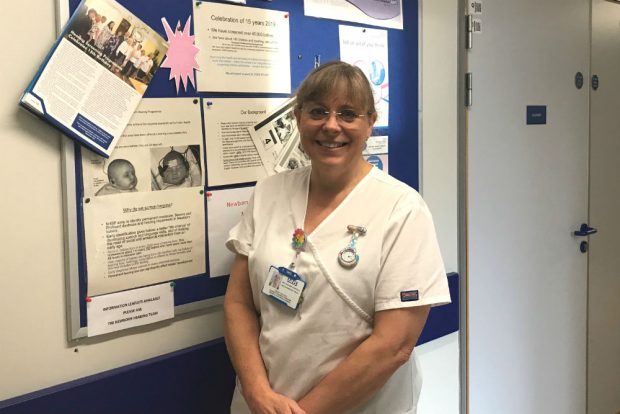
Background
Before I was a newborn hearing screener, I was an audiologist for 38 years — the last 6 of those working in paediatrics. I tested children from birth to 18 years old, including children with complex needs.
This also involved seeing babies who had been referred from the newborn hearing screening programme for otoacoustic emmissions testing (OAE) and auditory brainstem testing (ABR). This role came with its own challenges, requiring babies to be sleeping during long appointment times, or getting children and toddlers to cooperate.
Working in soundproofed rooms and controlling noise levels was one condition that was not a problem.
When a newborn hearing screener post became vacant I decided to apply. Newborn babies generally stay where they are put, can be tested in their hospital cots, and co-operation (other than sleeping) is not required.
Newborn hearing role
From my experience, the perception of the screening role from people outside the profession (and even audiologists) greatly differs from the reality. Many think that it is simple, undemanding, “a nice little job”, or “how lovely, dealing with newborn babies.” I have also heard “won’t you find it a bit unchallenging, after being an audiologist?”
The reality is I love being a screener, and yes, it is nice to deal with new mums and their babies. As to ‘simple’, ‘undemanding’ and ‘unchallenging’, they do not know the half of it!
Having been used to patients coming at set appointments in a soundproofed room, one of the biggest challenges I found was the test environment.
Being a screener on the ward
As screeners on the post-natal ward, we try to see babies at an appropriate time for them. This means when baby is not feeding or unsettled, and not when someone else is with mum or baby.
Other health professionals such as midwives, paediatricians, health care assistants and charity representatives also need to spend time with mum or baby. Because of this, you can often find yourself going back several times to the same baby, trying to get an appropriate opportunity to screen them.
In addition, the noise levels on the ward can be high. Visitors, health professionals talking to mums in the bay, and mobile phones on loudspeaker are just some of the contributing factors. The more babies that are born, the bigger the workload and the noisier the conditions.
Ward to clinic
When screening in clinic, we are lucky to have a soundproof room that we use, but clinic carries its own challenges in terms of time.
A limited amount of time is given for each screen, but babies are not always settled at their appointment slot. If they need an automated ABR (if we obtain a ‘no clear response’ to their first automated OAE (AOAE) test), there is no additional time allowed for this.
When you throw difficulties into the mix, being flexible as well as having good communication skills to ensure that parents are happy, and all babies are seen, definitely helps.
Admin, and more admin
The other frequent misconception about hearing screening, is that we spend most of our time screening. Personally, I was amazed at the volume of admin required in the job.
Once we have printed the proformas for all the new births, a lot of time and effort goes into locating them. They may be on the post-natal ward, still in the labour suite, or in special care. In some cases, mums have been transferred to another hospital, babies have been born at home, or mums have gone home straight from the labour ward.
Lots of checks and cross checks need to be carried out every day, and test results need to be uploaded to the national IT system and outcomes set. The baby’s personal child health record (red book) also needs to be completed and outcome recorded in the baby’s medical notes.
The special care baby unit (SCBU) must also be checked every day, as these babies need to be screened as near to discharge as possible (when all treatments and interventions are complete).
Nurses must then complete the SCBU risk factor form. The screens should be explained to parents and they should have given their consent prior to testing.
The time each baby spends in SCBU is carefully checked as there is a different protocol for babies who spend over 48 hours in SCBU. We need to keep track of babies’ movements when they are transferred to and from specialised units in other hospitals.
All of this amounts to a considerable amount of time on ‘behind the scenes’ work to ensure all babies are screened by 4 weeks of age or 44 weeks gestational age.
Having said this, and despite the job role being different to my expectations, I love what I do and have a lovely team with whom I work. There are absolutely no regrets.
If you are interested in becoming a newborn hearing screener, NHS jobs has detailed job descriptions from NHS organisations that provide newborn hearing screening locally.
Anyone who meets the person specification can train to be a newborn hearing screener.
You can do the training (e-Learning), learn hands-on practical communication and clinical skills, and get the required qualification (a level 3 diploma), while working as a screener.
The diploma is not a requirement if you hold a current health care professional registration.
PHE Screening blogs
PHE Screening blogs provide up to date news from all NHS screening programmes. You can register to receive updates direct to your inbox, so there’s no need to keep checking for new blogs. If you have any questions about this blog article, or about population screening in England, please contact the PHE screening helpdesk.